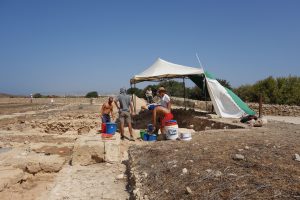Polish archaeologists unearthed remains of buildings by the agora of Nea Paphos, ancient capital of Cyprus and uncovered the layout of streets in the city.

The team of Polish archaeologist, led by Ewdoksia Papuci-Władyka, hoped to find the ancient port of the capital, that was expected in the vicinity of the North-West gate. In previous years archaeologists have conducted a lot of fieldwork involving geophysics in order to locate the port. They’ve discovered rectangular structures believed to have been part of the port’s infrastructure. The researchers opened numerous test trenches to verify their assumptions and learn more about the natural environment in which Paphos was located. Unearthed natural layers of sand, dirt, and mother rock exclude however the existence of harbour or docks in the past in the area of interest they have chosen. The geophysical measurements were continued in other parts of Paphos, with intention of creating a complete map of the ancient city.

A plan of structures of the agora was created thanks to GPR measurements, revealing that the buildings on its South-East side were dense. The researchers were also able to locate the North-East corner of the portico that encompassed the agora. Magnetic measurements revealed a round structure possibly related with use of fire. Excavations revealed that the anomaly was caused by a kiln used to burn lime. According to the researchers, this indicates that during the time it was used, parts of the city, including the agora were no longer important and served as a quarry. A different find, in form of a furnace for melting metal, was dated back to the time of Augustus’s reign at the turn of the eras.
Meanwhile, excavations uncovered a complicated hydraulic system of two connected, waterproof basins and a portion of a terracotta pipeline. A bit further, near the eastern entrance to the agora archaeologists have unearthed remains of a well. It was filled with numerous artefacts, such as stone blocks, fragments of pottery vessels, and even bone dice. The well was 6 metres deep and was used possibly until half of the 2nd century AD.
(after Ewdoksia Papuci-Władyka & Nauka w Polsce)